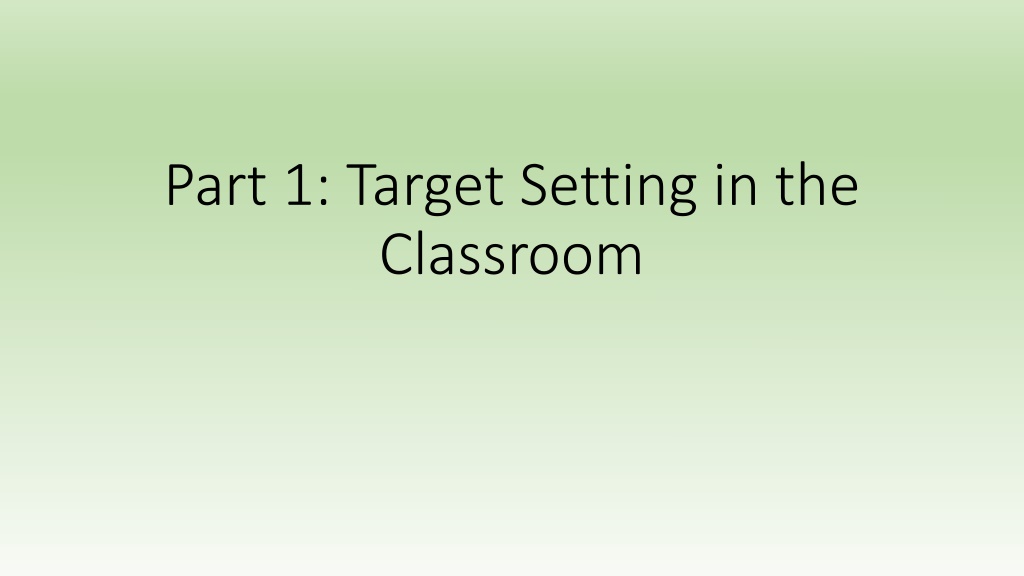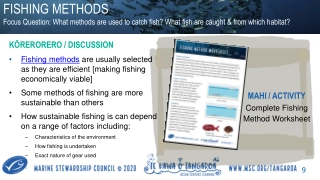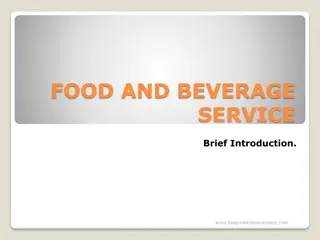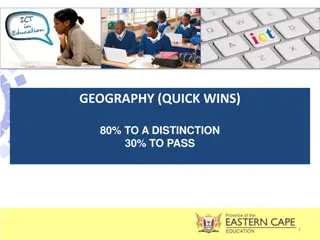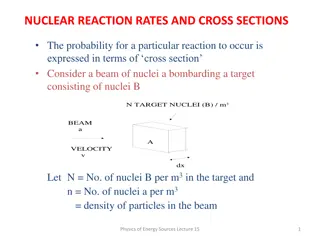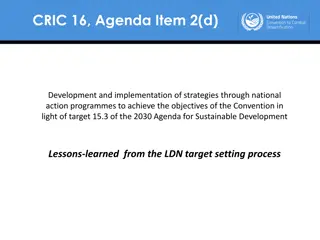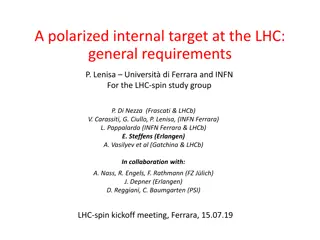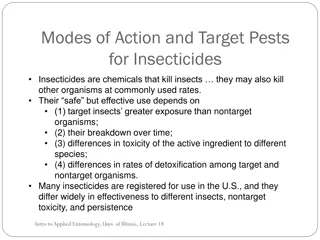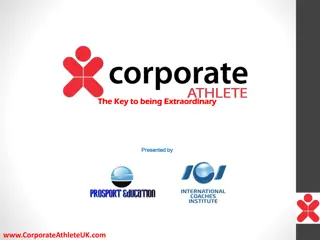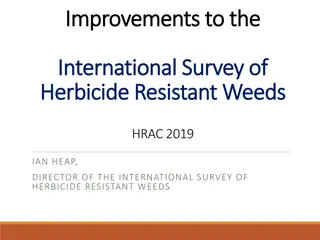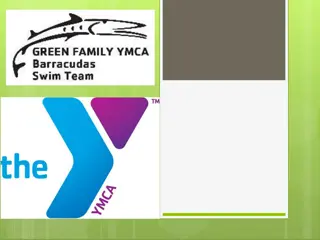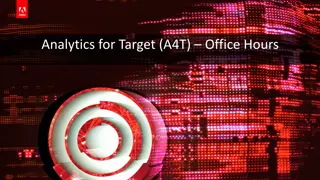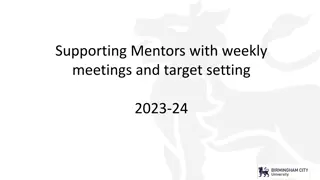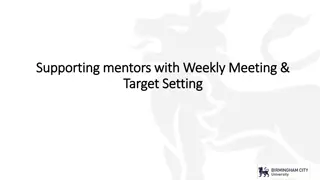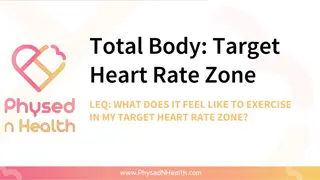Understanding Target Setting in Education
Target setting plays a crucial role in assessing student progress and holding schools accountable for pupil attainment. Teachers collaborate with school leaders to set long-term targets for students based on data analysis, aiming for specific outcomes by the end of the academic year. The process involves monitoring progress regularly and aligning with national data requirements. From Early Years Foundation Stage to Key Stage 2, targets are set for each year group, ensuring collective responsibility for student achievement. Understanding this process is essential for teachers to support student development effectively.
Download Presentation

Please find below an Image/Link to download the presentation.
The content on the website is provided AS IS for your information and personal use only. It may not be sold, licensed, or shared on other websites without obtaining consent from the author. Download presentation by click this link. If you encounter any issues during the download, it is possible that the publisher has removed the file from their server.
E N D
Presentation Transcript
Part 1: Target Setting in the Classroom
What is Target Setting An integral part of the assessment cycle in every school. A system for holding schools and staff accountable for pupil attainment and progress. (Can link in to performance related pay) Headteachers have to set targets for KS1 and KS2. Feeds into national data and local data which is published and holds schools accountable.
What does this mean for you a teacher At the start of every academic year you will be invited to a target setting or data conferencing session with your head or line manager. In this session you will be invited to set long term targets for pupils to reach a prescribed level of attainment by the end of the year or key stage (for example, a specific outcome in a national assessment, or category of teacher assessment), with progress monitored over time, often termly. You should look at existing data for attainment and progress for each child within your class. You should have discussions about each child and then a target will be set stating what the expected outcomes for each child by the end of the year should be. You will be given a % attainment for the whole class in reading, writing, maths and often science - for example 85% at Expected for reading.
How the process works. In National data, attainment and progress is measured from EYFS to KS1, then from end KS1 (Year 2 SATs) to end KS2 (Year 6 SAT s) End of Key Stage data is everyone s responsibility not just Year 2 and 6 teachers though to be honest they do carry a lot of responsibility. (This is why you must know your class very well so you can discuss targets with confidence) Every year group has whole class targets set and teachers are accountable for how well their class does. In EYFS progress is measured from a baseline. Children are expected to reach a GLD (Good level of development) by the end of the year.
How it works continued. In EYFS a baseline assessment is usually done within the first couple of months in school. Most children are then expected to reach a Good Level of Development by scoring a minimum 2 points across all areas of learning within the Foundation Stage profile. Of course consideration is given to a child s starting points. In Year 1, end of EYFS data is considered when setting end of year 1 targets. There is no direct correlation between the foundation stage profile and national curriculum expectations though how well a child has done in reading, writing , number and shape and space are fair indicators of how children might progress in English and Maths in Year 1.
Year 1 Look at the table below that shows end of year attainment for an EYFS class pay particular attention to Literacy and Maths - note those children who did not score 2 points and those who scored 3. Data like this would be used to set targets for the end of year 1. Teachers would be expected to think of ways of supporting those pupils who did not score 2 points and ways of extending those pupils who scored 3. Generally speaking a child who scored 3 in reading and writing would be expected to continue as a higher attaining child in English is KS1 . Children obtaining a Good level of Development have green tick.
Year 1 continued. Since the abolishment of levels, schools have been left to their own devices to have an assessment system and system for tracking progress. Basically they have had to invent their own levels For the purpose of this presentation I have used the following descriptors for describing levels of attainment. Emerging 1 and Emerging 2 , Developing 1 and 2 , Secure 1 and 2 and Greater Depth. We used these in my school and we expected pupils to enter a year group as EMG 1 and leave all being well- as SEC 2. Don t worry too much about the labels used as they will vary from assessment systems and schools. Have a look at your placements school tracking system and compare. You can clearly see the correlation between EYFS scores and end of year targets for year 1. Note also ideas for support listed. Sum2 EYFS GLD GLD Not GLDEmerging (40-60+)Emerging (40-60+)Emerging (40-60+) SEC 1 GLD Exceeding Exceeding GLD Expected Expected GLD Exceeding Exceeding GLD Expected Expected GLD Exceeding Exceeding GLD Exceeding Exceeding GLD Exceeding Expected Not GLDEmerging (40-60+)Emerging (40-60=)Emerging (40-60+) SEC 1 Last Year's Last Year's Expected Expected Last Year's Expected Expected Last Year's Expected Expected Reading Reading Target SEC 2 SEC 2 Target SEC 2 SEC 2 SEC 1 GD SEC2 GD SEC 2 GD GD SEC2 DEV 2 Traget SEC 2 SEC 2 SEC 1 GD SEC 2 SEC 2 SEC 2 SEC 2 GD GD SEC 1 Writing Writing Sum2 Sum2 Sum2 Maths Maths GLD Full name CHILD 1 CHILD 2 CHILD 3 CHILD 4 CHILD 5 CHILD 6 CHILD 7 CHILD 8 CHILD 9 CHILD 10 CHILD 11 Booster HA group all subjects Exceeding Expected Expected Expected Expected Exceeding Exceeding GD SEC 2 GD SEC 2 GD GD GD Higher attaining group English HA group English HA group all subjects Support writing Small group support and pm interventions
Year 2 In Year 2 targets are set using national descriptors of PKF -Pre Key Stage, WTS Working towards standard, Expected and Greater Depth. Note here how phonics scores have also been used to set targets and end of year 1 Teacher assessments. Here discussion would center around the child as a whole their levels of maturity, ability to focus and learn, support from home etc when setting targets. Note targets have to be challenging look at Child 1 for example even though they only got Sec 1 at the end of year 1 they would be expected to be at the Expected level by the end of year 2. YR Sum2 YR Sum2 YR Sum2 YR Sum2 Y1 Sum2 Y1 Sum2 Y1 Sum2 Y1 Sum2 Y1 Sum2 Phonics Reading Reading Phonics 34 39 36 6 16 reading Target EXS GD EXS PKF WTS Target EXS GD EXS PKF WTS Target EXS GD EXS PKF WTS Writing Writing EYFS GLD GLD GLD Not GLDmerging (30-50= Not GLDmerging (40-60= writing Maths Maths Maths Value GLD Full name Child 1 Child 2 Child 3 Child 4 Child 5 Expected Exceeding Expected Expected Expected Expected Emerging (30-50+ merging (30-50 Emerging (40-60= merging (40-60 Expected Expected Expected 34 Y1 Sec2 Y1 Sec1 Y1 Sec1 39 Y1 GD 36 Y1 Sec2 Y1 Sec2 Y1 Sec1 6 YR Dev1 YR Emg2 YR Dev2 16 Y1 Dev1 Y1 Emg2 Y1 Dev1 Fallen slighlty behind Ensure you challenge Fallen behind in maths SEN Will struggle lots of support needed Y1 GD Y1 GD
Years 3, 4 and 5 In these years groups school revert back to their own assessment criteria using previous data to set targets. The Year 2 end of year data is crucial in that it is used to measure progress for Year 6 pupils when they sit their SAT s and their progress data is calculated. Note here how data from PIRA (Reading) and PUMA (Maths) tests are used to help set targets. Essentially the more information we have about pupils the more accurate target setting will be. Every class will be given a % of children working at the expected (SEC 2)and greater depth standard in Reading, Writing and Maths. Y2 Sum2 Maths WTS WTS GDS EXS EXS GDS GDS Writing SAT TA Disadvantaged Phonics Value Reading SAT WTS WTS EXS EXS EXS GDS GDS Target Maths Term of birth Target Read Target Write Y2 Sum2 Y2 Sum2 WTS WTS EXS EXS PK4 GDS EXS Y2 Sum2 Y2 Sum2 Puma SS Phonics 36 31 SAT TA Pira SS TA Full name Child 1 Child 2 Child 3 Child 4 Child 5 Child 6 Child 7 SEC 1 DEV 2 SEC 2 SEC 2 SEC 2 GDS GDS SEC 1 DEV 2 SEC2 SEC 2 DEV 2 GDS GDS SEC 1 SEC 1 GDS SEC 2 SEC 2 GDS GDS Y N N N Y N N Aut Sum Sp Sp Aut Sum Aut 36 31 94 83 95 81 Booster Didn t pass phonics resit 101 101 98 104 103 105 102 99 107 105 Behaviour Refuses to write Boost writing - potential
Year 6 The end of year data for this cohort is used to compare school performance nationally and locally. Progress is measured from the cohorts attainment when they were in year 2. Schools falling below floor standards or have consistently (last 3 years) falling standards may be inspected. School performance data is published in ASP (Analyze School performance ) and for us in Cornwall, Corestats.
Year 6 Target example In this example you can see that some pupils have recently joined the school. Targets are set using End of Year 2 data. Children have to maintain (at least) expected progress from these standards. So if they got EXS in Year 2 they have to get EXS in Year 6. Look at Child 1. You can see they achieved EXS standard in writing at the end of year 2 but are working slightly below in year 5. (This often happens when pupils come from other schools and can be part of a discussion but ultimately they have to be expected by the end of year 6 to maintain progress.) Child 3 did not meet expectations in Year 2 but has made good progress in year 4 and 5 since joining the school. Challenging targets have been set for this child. Pupils in Year 6 - 30 pupils 100% Y2 Sum2 Y2 Sum2 Y2 Sum2 Y3 Sum2 Y3 Sum2 Y3 Sum2 Y4 Sum2 Y4 Sum2 Y4 Sum2 Y5 Sum2 Y5 Sum2 Y5 Sum2 Reading GDS GDS WTS EXS GDS GDS Reading Reading Reading SAT TA SAT TA SAT TA Writing EXS GDS WTS EXS EXS GDS Target GDS GDS EXS EXS GDS GDS Target EXS GDS EXS EXS GDS GDS Target EXS GDS EXS EXS GDS GDS Maths EXS GDS WTS EXS GDS GDS Writing Writing Writing Maths Maths Maths Maths Read Write Full name Child 1 Child 2 Child 3 Child 4 Child 5 Child 6 Y5 Sec2 Y5 GD Y5 Sec2 Y5 Sec2 Y5 GD Y5 GD Y5 Sec1 Y5 GD Y5 Sec1 Y5 Sec2 Y5 GD Y5 GD Y5 Sec2 Y5 GD Y5 Sec2 Y5 Sec2 Y5 GD Y5 GD Writing - joined in year 5 Y3 GD Y3 Sec2 Y3 GD Y4 GD Y4 Sec1 Y4 GD Y4 Dev2 Y4 GD Y4 Sec1 Booster for writing - joined in Year 4- watch Joined in Year 5 Y3 GD Y3 GD Y3 GD Y3 Sec2 Y3 GD Y3 Sec2 Y4 GD Y4 GD Y4 GD Y4 GD Y4 GD Y4 GD
Some issues with Target Setting Its very time consuming some school do reviews every half term. You really need to keep your target setting document as a live document. Keep referring to it and alert SMT if your are worried your class are not on track. Occasionally you may not agree with the attainment levels given by the previous teacher be aware all staff are under immense pressure to show progress- baseline your class as soon as you can and discuss with your line manager. Liaise very closely with the classes previous teacher. Sometimes unrealistic targets are set. Schools have their hands tied in many respects as they have to set targets that are in in line with national standards. Issues arise when you have a poor performing cohort or group of cohorts who are not going to meet standards. To mitigate this know your class very well. There is always a story behind data it won t be accepted as an excuse for poor performance but it can be part of a conversation. Inspectors look more in pupils books for signs of progress -ensure it can be seen there .
Part 2: Understanding School Performance Data A brief overview
Data Analysis End of KS data is presented to schools in many forms. ASP (Analyse School Performance) is the latest document to report pupils results and replaces Raise on line. In Cornwall, Corestats also send information to schools regarding their data. Fisher Family also provide information. There is a whole raft of information available to us often the same information is presented in many different formats.
Whats important. Your SMT in school will analyse data very carefully and look for trends and patterns. As a teacher you will need to know your schools strengths and weaknesses as this information will link to your class target setting. You will need to be aware of how well your school has done in attainment and progress when compared to other schools in the country of a similar type. You will need to focus on some key groups Disadvantaged pupils, gender differences ,SEND and previous high attainers are the main ones.
Attainment Attainment is pretty straight forward it s the percentage of pupils reaching the expected or higher standard of attainment in Reading, Writing and Maths. Initially combined scores are reported - % attainment in Reading, Writing, Maths combined. This can be frustrating for schools as many times the writing scores ( traditionally the most difficult to attain)can bring a school combined scores down significantly. Have a look at the charts below and draw some conclusions. What do you think an area to explore would be? What could a school do about this? How may it impact on your class targets?
Scaled scores Raw scores from KS2 tests are converted to scaled scores to ensure accurate comparisons can be made over time. (Some tests may be harder than others so this ensures consistency.) Pupils scoring at least 100 will have met the expected standard on the test. The lowest scaled score that can be awarded on the tests is 80 the highest 120. In the case of national tests the average scaled score is often higher than 100 as government targets change. The chart below shows the national scaled score average and the schools.
3 year trends ASP gives statistics for the last 3 years. This way schools can spot trends. Declining standards for 3 years can trigger an inspection. What conclusions can you draw for this school?
Progress A pupils progress score is the difference between their actual KS2 result and the average result of those in their prior attainment group in KS1 . If a child received 102 in reading at KS2 and the average KS1 reading score for her prior attainment group was 101 - her progress score would be +1. School level progress scores are created by adding together the progress scores of all the pupils in year 6 and dividing by the number of year 6 pupils in the school. This process is repeated for each of reading, writing and maths. Schools will have three progress scores: Average progress in mathematics; Average progress in reading; and Average progress in writing.
Progress continued Progress scores will be centred around 0, with most schools within the range of -5 to +5. A score of 0 means pupils in this school on average do about as well at KS2 as those with similar prior attainment nationally. A positive score means pupils in this school on average do better at KS2 as those with similar prior attainment nationally. A negative score means pupils in this school on average do worse at KS2 as those with similar prior attainment nationally.
Have a look at the progress scores for this school and consider what questions you may ask.
Progress continued- This slide is an example of how we can find out more about how key groups have performed. Look at gender differences in attainment and progress what can you see? How might that information form part of the school improvement plan? What would be the implication for whole class targets throughout the school?
More information Read this document https://assets.publishing.service.gov.uk/government/uploads/system/u ploads/attachment_data/file/560969/Primary_school_accountability_s ummary.pdf.pdf
